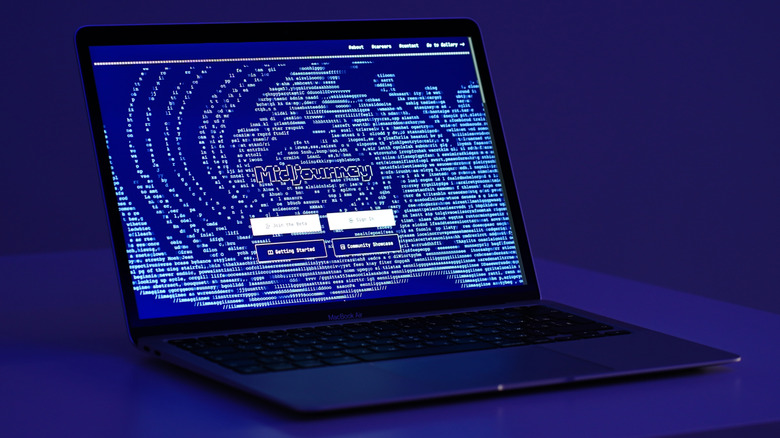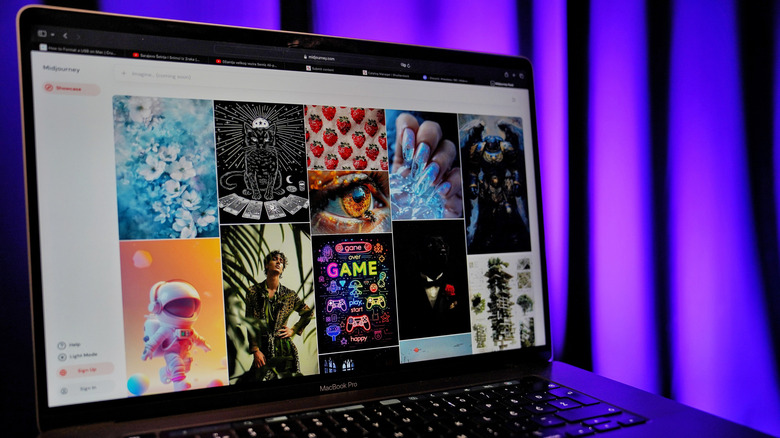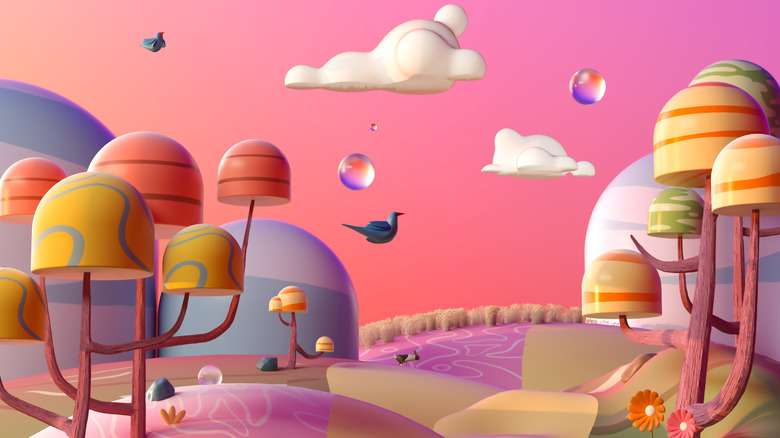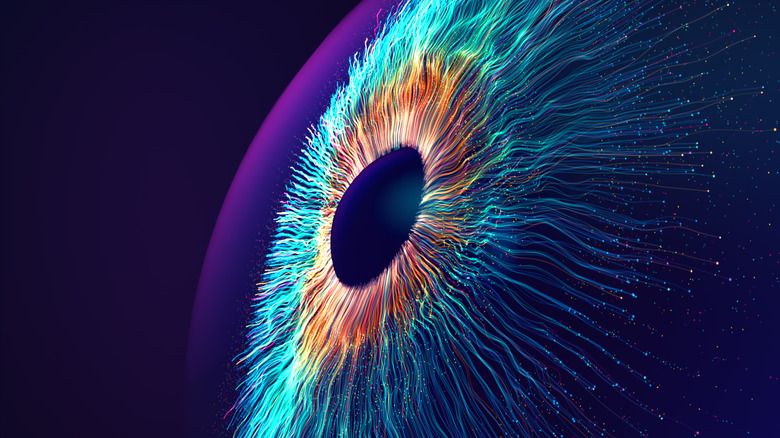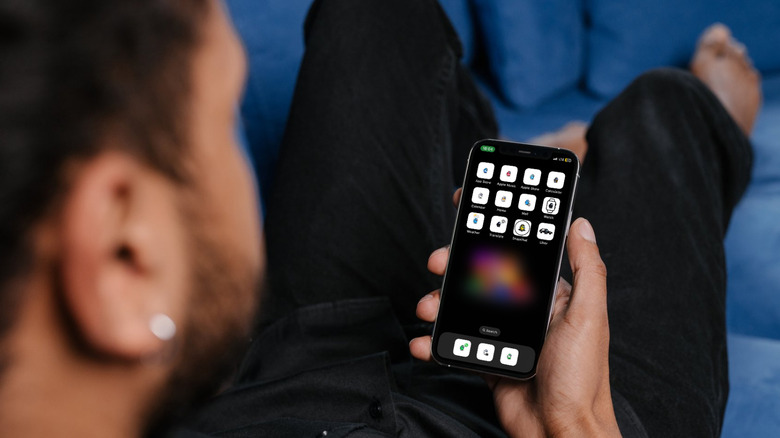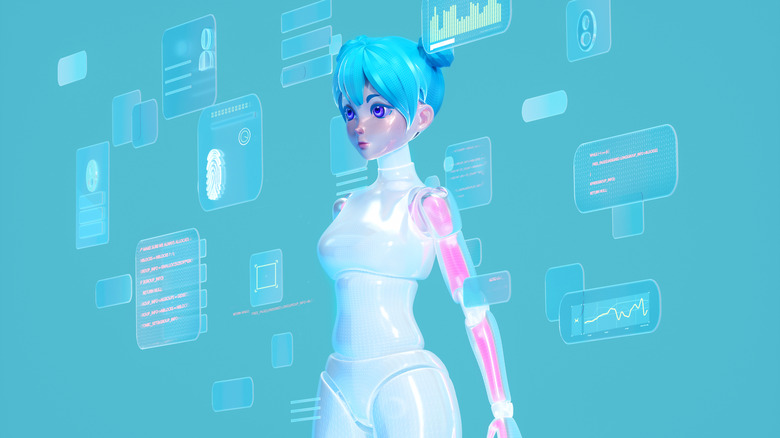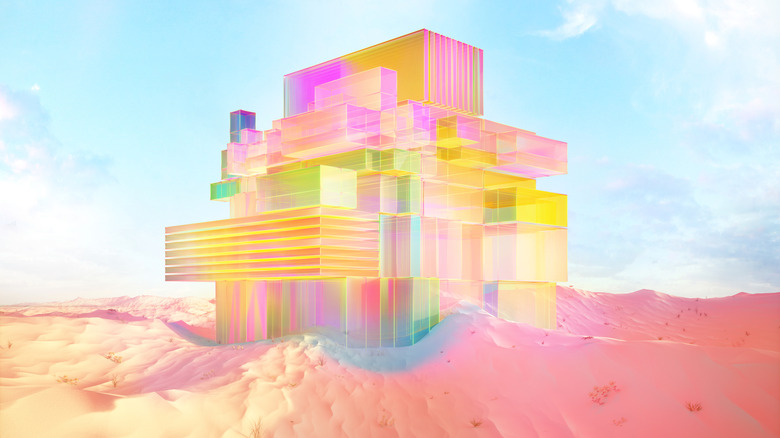6 Creative Uses For Midjourney AI, According To Users
If you've been anywhere near the AI art scene, you've probably seen the magic of Midjourney — a generative AI tool that turns text prompts into surreal visuals. Since its launch in 2022, Midjourney has skyrocketed in popularity, becoming one of the top AI image generators. Initially, its charm lay in a unique, stylized aesthetic, eschewing photorealism for a vibrant, painterly quality. Users dove in, experimenting with everything from epic fantasy scenes to illustrative digital artwork.
But as Midjourney evolves, with sharper processing and improved features, creatives are finding even more inventive ways to put it to work. Indie game designers are fleshing out RPG worlds, while entrepreneurs whip up quick product mockups – all with a few well-placed prompts. We took a deep dive into some of the most creative uses for Midjourney right now, and whether you're a seasoned user or just AI-curious, you might find some ideas to try out yourself.
Custom brand images
Business owners are turning to Midjourney to create visuals that are polished, cohesive, and feel genuinely on-brand — without breaking the bank on creative teams, stock photo subscriptions, or sifting through the same stale imagery as everyone else. Ethical debates around AI's role in creative work continue, but its practical appeal is undeniable. With AI-generated content, brands can craft graphics that capture their essence, while trimming time and cost from the creative process. It's Economics 101, especially for small businesses.
What makes Midjourney stand out for Matty Brownell, founder of a branding agency for small businesses, is its iterative design process. By fine-tuning ideas through AI, he delivers graphics that reflect his clients' identities, minus the marathon brainstorming sessions. Users can upload reference images to guide the tool's output, and adjust results as much as needed to achieve their vision. Brownell also highlights the Blend tool, which allows him to merge elements from multiple concepts, unlocking even greater creative flexibility. It's a level of customization that traditional workflows often struggle to match, and it dramatically shortens the journey from idea to execution.
Bringing dreams to life (literally)
We've all been there — you wake up from a vivid, complex dream, only for your brain to hit the delete button on the entire thing. Now, you're left blank, knowing you've been through something, but not sure what exactly. If you were hoping for news that AI can now recover those elusive dream fragments from the recesses of your mind, sorry to disappoint you — we're not there yet. However, what AI can do, as Reddit user Jae_Kingsley has discovered, is help render the content of the dreams you do remember into visuals that you can share with others. It's not mind-reading, but it's a close second.
To make this work, though, you'll need to know how to write specific and detailed prompts for Midjourney. Dreams are often messy, abstract, and defy logic (why was your third-grade teacher juggling flaming pineapples?), and describing them comes with the inevitable "lossiness" of language — the gap between the vivid imagery in your head and the words you use to describe it. While AI can partially bridge this gap, it still relies on your ability to convey as much detail as possible. By experimenting with descriptions – focusing on elements like colors, textures, emotions, and unique details – and iterating on your inputs, you should be able to guide Midjourney toward creating something that feels close to what you imagined. You can make the output more immersive by pairing Midjourney with AI video generators like Hailuo or Kling to add movement and depth to your concept.
Device wallpapers
If you're the kind of person who's big on device personalization, custom wallpapers are a no-brainer. But instead of turning to stock photo sites or pricey wallpaper apps, many people are simply using Midjourney to create their own. It's a perfect example of how AI can amplify personal expression in the digital age. Midjourney fans are generating wallpapers that reflect niche interests, mash up concepts that wouldn't normally coexist in the real world, or play around with unique artistic styles. Whether it's for your iPhone, Android, or desktop, a few well-crafted prompts can produce stunning wallpapers.
Again, to level up your results, you'll want to hone your prompting skills. This means getting specific about the details, like aspect ratio (so it fits your screen perfectly), focal points (what stands out in the image), and art style (is it photorealistic, abstract, or painterly?). Knowing a bit about photography concepts like the rule of thirds or lighting effects can help too.
For example, if you're dreaming of a Spiderman-themed wallpaper set in Narnia, you'll need to hone in on which version of Spiderman do you want — classic comic-book Spidey, a cinematic version, or maybe even a futuristic reimagining? What does Narnia look like in your vision — is it a snowy forest with the iconic lamppost, or a lush green Aslan-led utopia? The more details you provide, the better the AI will understand exactly what you're aiming for.
App icon design
Another way users are tapping into Midjourney for device personalization is by creating custom app icons. Android users have long been spoiled with robust customization options, but iOS has been stuck playing catch-up. It wasn't until iOS 18 that Apple finally let users change the look and placement of iPhone and iPad app icons on the home screen — and even now, the built-in options are pretty bare-bones. Swapping out proprietary icons for third-party ones remains a tedious process, but at least the Midjourney route makes it worth the grind by letting you design icon packs that feel truly personal.
Whether you're dreaming of sleek minimalist icons in pastel shades or a bold, cyberpunk-inspired set straight from the future, Midjourney gives you the creative freedom to make it happen. You can dial in everything from color palettes and design styles (flat, 3D, hand-drawn) to niche themes like your favorite game, show, or aesthetic trend. Once your designs are ready, save and apply them using apps like Shortcuts (on iOS) or third-party launchers (on Android). Combined with some of the other customization features on iOS 18, you can build an iPhone home screen that feels 100% you — and maybe even flex on your Android-using friends for a change.
Virtual worldbuilding
Midjourney is also a standout tool for creating detailed, imaginative worlds in all kinds of creative projects, especially if you're experimenting or working on a tight budget. Indie game developers are using it to craft everything from sprawling fantasy landscapes to gritty urban settings, as well as intricate props like mystical artifacts and futuristic gadgets. It's a smart way to flesh out ideas for game levels, themes, or aesthetics without the hassle of complex or expensive design software.
It's not just about worldbuilding, either. Midjourney is also useful for creating unique, imagined characters, whether you're working on facial features, costumes, or accessories. The Character Reference tool ensures they stay consistent across scenes, which makes it perfect for projects that need continuity. The Retexture tool lets you put a fresh spin on an existing character if that's what you want to do instead, like Reddit user MattB_289.
Whether you're sketching concepts for a manga, bringing whimsical children's book illustrations to life, or designing worlds for an indie game, Midjourney makes it easy to explore, refine, and execute your creative ideas. The possibilities are as vast as your imagination will allow.
Architecture and interior design
For architects and interior designers, Midjourney's allure lies in its speed and capacity for creative exploration. The AI tool allows them to experiment with materials and textures that would otherwise take hours to model manually. As documented by Architect Magazine, Italian architect Cesare Battelli leverages Midjourney to breathe life into concepts that span from the ancient to the futuristic. He's used it to envision the architecture of the Tower of Babel, for example, and the results achieve a striking balance between technical detail and rich atmospheric character.
Interior designers are using the tool to visualize design options for existing spaces, like Reddit user UnnamedCzech, or imagine entirely new concepts for space design. Whipping up the visuals for a modern loft that feels like a Renaissance painting will take minutes instead of months, making it a fantastic way to share ideas with clients and give them a vivid sense of how a space might look and feel.
What's really cool is that Midjourney isn't just for professionals — clients and hobbyists can dive in and create their own designs, which means the creative process is more inclusive. Whether you're redesigning your home or proposing the next iconic skyscraper, Midjourney is opening up opportunities for everyone to participate in design. It's quick, user-friendly, and transforming our approach to what's achievable in architecture.
Wherever you stand on the ethics of AI, there's no denying that Midjourney is driving some impressive creative breakthroughs. We'll have to see how the conversation and its use evolve, but hopefully these use cases have inspired you to at least give it a try.
